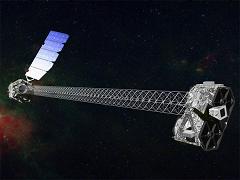Georgia Tech astrophysicist assists with NASA’s NuSTAR mission

NASA
NASA launched its newest X-ray telescope into space this week. The Nuclear Spectroscopic Telescope Array or NuSTAR for short will examine a number of black holes never seen by human eyes before, and a local astrophysicist will be paying close attention, because he helped plan the mission.
Georgia Tech Assistant professor and Astrophysicist David Ballantyne says one of the goals for the high-energy X-ray telescope is to gain a greater understanding into the role black holes play in the formation of galaxies. A black hole is a celestial body with such a strong gravitational field that light cannot escape it. Based on measurements, Ballantyne and many other astrophysicists believe black holes and galaxies co-evolve together.
“One way of trying to understand this is that you have to look for growing black holes. If you can find growing black holes and then study the galaxies these growing black holes that these are situated in, you can hopefully learn about what processes that are going on that allows this co-evolution to go on.”
Ballantyne says low-energy X-ray telescopes have been used to examine black holes for years. But he’s hopeful NuSTAR will allow scientists to find growing black holes that were previously invisible, because it captures images of high-energy X-rays.
“Which we haven’t been able to do before and will allow us to detect highly buried black holes in the centers of galaxies, which are surrounded by dust and gas and junk around them, which tends to absorb out the low-energy X-rays.”
Ballantyne has spent the past six years helping plan for the mission. He will also assist with analyzing the data as it begins arriving from space in the next few months.
For More Information:
NuSTAR home at California Institute of Technology
9(MDAxODM0MDY4MDEyMTY4NDA3MzI3YjkzMw004))








